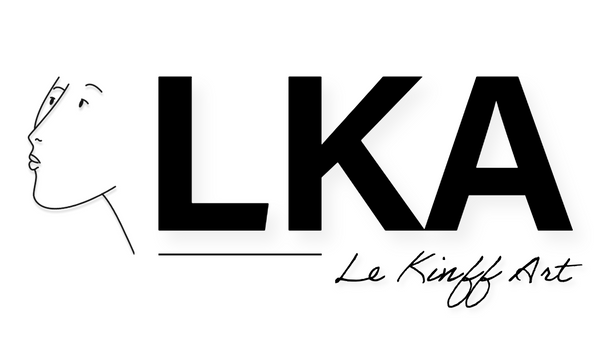The artist
Linda Le Kinff: the daring alchemist between tradition and modernity
Imagine an artist who, from the outset, takes you on a journey between France and Brazil, then unceremoniously whisks you away to Italy, Japan, India... That's a bit like Linda Le Kinff's universe: a whirlwind of colors, cultures and techniques, where women display generous curves, their heads full of dreams and cats prowl everywhere as silent witnesses.
Born to a French mother and a Brazilian father, Linda grew up in a dual culture that deeply influences her painting: the sophisticated grace of the French artistic tradition rubs shoulders with the vibrant palette of Latin American countries. However, nothing predestined her to pursue a career in art, since she initially followed a rather traditional academic path. It was the friction of life—meetings with painters, sculptors, and other free spirits—that led her to turn to canvas and pigments in the 1960s.

The decisive shock of her career? Italy. At 18, Linda discovered Florence and was literally amazed. Renaissance art overwhelmed her, so much so that she returned there regularly for fifteen years, mopping up all sorts of ancient techniques (egg tempera, the use of gold leaf, copper engraving, etc.) and mastering more recent ones (airbrushing, acrylics, screen printing). In Franco Cantini's studio, she rubbed shoulders with masters like Zancanaro and Chipola, whose influence would have a lasting impact on her style.
Another key moment in her career occurred by chance—or, dare we say, by a stroke of fate—in 1974: while working on a lithograph in Arcueil, she met Sir Myles Cook, director of Christie's Contemporary Art in London. This marked the beginning of a collaboration lasting more than twelve years, thanks to which Linda exhibited throughout Europe, Japan, and even Australia. Her works traveled from one gallery to another (Burlington Art Galleries in Hong Kong, Krashin Gallery in the United States, etc.) and gradually conquered the international scene.

Her successive travels (to India, where she "encountered" color, to Japan, where she explored sumi-e under the guidance of master Sujiama Yu, to Morocco alongside the poet Chabia, etc.) continue to fuel her imagination. Linda brings back techniques, motifs, and visions that accumulate in her repertoire. Little by little, her style is forged, both anchored in the heritage of the great masters of the Renaissance and open to all forms of audacity. Linda cites Matisse, Klimt, Modigliani, and Picasso among her inspirations; she readily adopts the freedom of lines, even Cubist deconstruction, to better tell her own stories.
The "Le Kinff touch" is recognizable at first glance: voluptuous feminine silhouettes, cats fluttering through the decor, bright and shimmering colors applied to wood or canvas. The varnishes and mixtures she invents allow her to achieve a unique chromatic density, combining classic finesse and vibrant modernism. She also enjoys oil pastels, ink, watercolors, and, recently, collage. This further multiplies the possibilities and reminds us that, for her, an artist only exists if they never rest on their laurels.

Her talent was soon noticed: in 1998, she became the official artist of the Football World Cup in France, which earned her the unprecedented honor of having one of her works minted as a commemorative coin. Then, in 2010, she was the first French artist selected to illustrate the prestigious Kentucky Derby: in a twist of fate, the horse she painted wore the number 4 and actually won the race under that same number… Coincidence? Some will see this as a nice snub to the idea that art and sport are two separate worlds.
Between her collaborations with the Park West Gallery (which opened America to her on a plate) and her numerous exhibitions around the world, Linda continues to diversify her mediums, even trying her hand at sculpture and screen printing. Always with the same credo: the artist must constantly innovate, even if it means taking risks, because creation is an eternal restart. She herself states: "We are only the artisans of a strange poetry that surpasses us."
Ultimately, how can we define Linda Le Kinff's art? It is both light and profound, timeless and fully anchored in our times. Her paintings speak all languages, as if her singular style, imbued with her French heritage, her Brazilian roots, and her wild escapades across the planet, contained within itself a universal message. The women she paints, reassuring and voluptuous, seem to whisper in our ears: "Beauty is everywhere, if we know how to look at it with a hint of audacity and reverie."
What is certain is that Linda Le Kinff leaves behind an inimitable trail in the history of art. And she has not finished surprising us, as this insatiable traveler still seems to have a thousand ideas to share, a thousand worlds to paint—always with her characteristically colorful gentleness.
